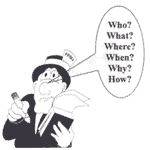
Facts and Details
The first sentence of a serious newspaper article is called the lead. Reporters usually place the important facts here.
What are facts and details?
Reporters discover the facts of a story by asking who, what, where, when, why, and how. The answers to these questions are called facts.
Newspaper and magazine writers rely on facts to support their statements. Facts and details can include information such as examples, reasons, statistics, causes, and effects, characters, events, descriptions. Recognizing facts and details are important.
Finding facts is important when the main idea is not stated. You will need to use facts to make inferences. Missing details or misreading details may lead to an incorrect assumption about the main idea.
How do I find facts and details?
Ask questions like who, what, where, when, why, and how. Once you find a fact evaluate its sources and value. For example, a writer might state that the average yearly family income for Canadian families is one hundred and twenty-five thousand dollars. If the writer based this idea on statistics from a one community the facts and statement are useless. They don’t apply to the average Canadian.
What can I do to remember facts and details?
You will remember facts and details if you underline, highlight, or note facts and details as you read. Try to produce a mental image as you read. Add detail to the mental image as you learn new facts or details. Organizing the facts or details you discover will help. You might try making lists, drawing diagrams, or using concept maps.